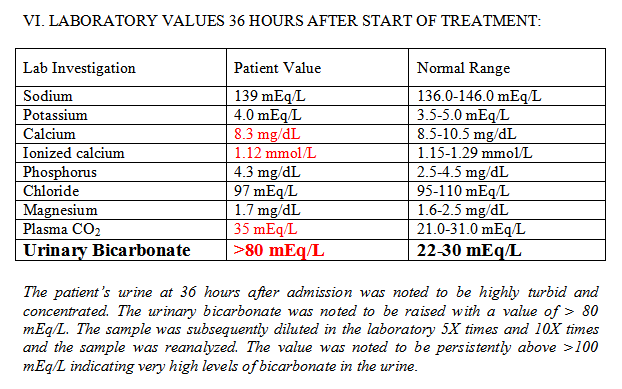
![]() Contributed by Ramachandra R Gullapalli, MD and Mohamed A Virji, MD, PhD
Contributed by Ramachandra R Gullapalli, MD and Mohamed A Virji, MD, PhD
I. PRESENTING COMPLAINTS AT ADMISSION
The patient is a 27-year-old male presenting with acute carpopedal spasm, tachypnea and pain in all the extremities. The patient has a history of difficulty speaking. The patient has a history of generalized myalgia and weakness of the body. There is no history of change in his vision or hearing. The patient has no ongoing nausea, vomiting or diarrhea. There are no urinary symptoms and no history of recent head injury. On initial examination, the patient was noted to be alert and oriented and somewhat dysarthric.
II. PAST MEDICAL AND SURGICAL HISTORY
The patient suffered a gunshot wound to the lower abdomen 5 months prior to the current admission and subsequently underwent an exploratory laparotomy and a repair of a gastric injury. Repair of the transverse mesocolon and small bowel resection with primary anastomosis was performed. Approximately 20 days after the surgery, the patient noticed the presence of a brownish colored fluid leak from the anterior wound of the abdomen which was subsequently diagnosed as an enterocutaneous fistula secondary to wound dehiscence. Two months later, the patient was readmitted when he developed mild acute renal failure with a blood urea level of 85 mg/dl and serum creatinine level of 3.3 mg%. The Fistula was noted to be still patent and discharging significant amounts of fluid. The patient was given fluid replacement therapy and subsequently discharged and remained under observation till the current admission.
III. FAMILY AND SOCIAL HISTORY
The patient lives at home with his family. The patient denies any use of tobacco, alcohol or illicit drugs.
IV. PHYSICAL EXAMINATION FINDINGS AT ADMISSION
V. LABORATORY INVESTIGATIONS AT ADMISSION


In view of the significantly reduced values of potassium and ionized calcium values, the patient was immediately started on fluid and electrolyte replacement therapy in the form of normal saline, potassium supplementation and calcium replacement.
V. LABORATORY VALUES 36 HOURS AFTER START OF TREATMENT
